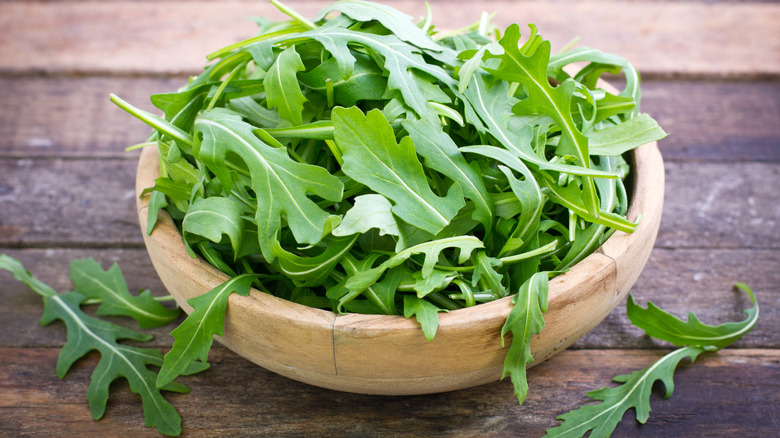Is Arugula More Nutritious Cooked Or Raw?
When it comes to preparing meals, it's often easiest to stick with what you know. Eggs for breakfast, salad for lunch, and chicken for dinner. And while this kind of practicality can save you money, calories, and stress, sometimes it can make mealtimes feel like a bore (per NBC News). Adding a little variety helps — even if you're just swapping out one leafy green for another. Trading out your usual spinach or kale for arugula is one sure-fire way to spice things up.
Celebrated by its fans for its peppery taste and culinary versatility, arugula originates from the Mediterranean coasts of Turkey, Portugal, and Morocco (per U.S. News & World Report). Now that we've added a little interest to our plates, how about a bit of mystery? While cleverly disguised as a type of lettuce, arugula is actually a cruciferous vegetable — in the same family as broccoli or cauliflower. And while all of these things make arugula a fun addition to any sandwich, flatbread, or salad — it's in the nutrition department that arugula really shines. But you might be wondering — if arugula is in the same family as broccoli, will cooking it kill off all these nutrients you speak of? Let's find out.
Nutritional benefits of arugula and the best way to eat it
If you're in need of some essential nutrients — arugula has got you covered. One cup has 20% of your Recommended Dietary Allowance (RDA) of vitamin K, and 4% of your RDA for vitamin C and folate (per Lettuce Info). Your immune system, blood, and bone health aren't the only things that will benefit from a heaping handful of this crunchy green. Arugula is also packed with calcium, potassium, magnesium, iron, and vitamin A.
Because it is a cruciferous vegetable, arugula also contains isothiocyanates, a molecule that offers anticarcinogenic, neuroprotective, antidiabetic, cardioprotective antioxidant, and antimicrobial benefits, per a 2022 review in Current Research in Nutrition and Food Science. If you're wondering how to prepare arugula to get the most nutritional bang for your buck, Lettuce Info states you don't have to overthink it too much. The cooking process may compromise the vitamin C, antioxidant, and mineral content of arugula a bit, but the difference is nothing to write home about. However, U.S. News & World Report reports that arugula also contains chlorophyll – a chemical that acts as a liver-protecting ninja. Because chlorophyll is killed by heat, it's best to eat arugula raw if you want to ensure your liver gets the goods. On the other hand, if you want to add a little arugula to your diet but the taste is a little much for you, Healthline states that cooked arugula has a much milder flavor.


